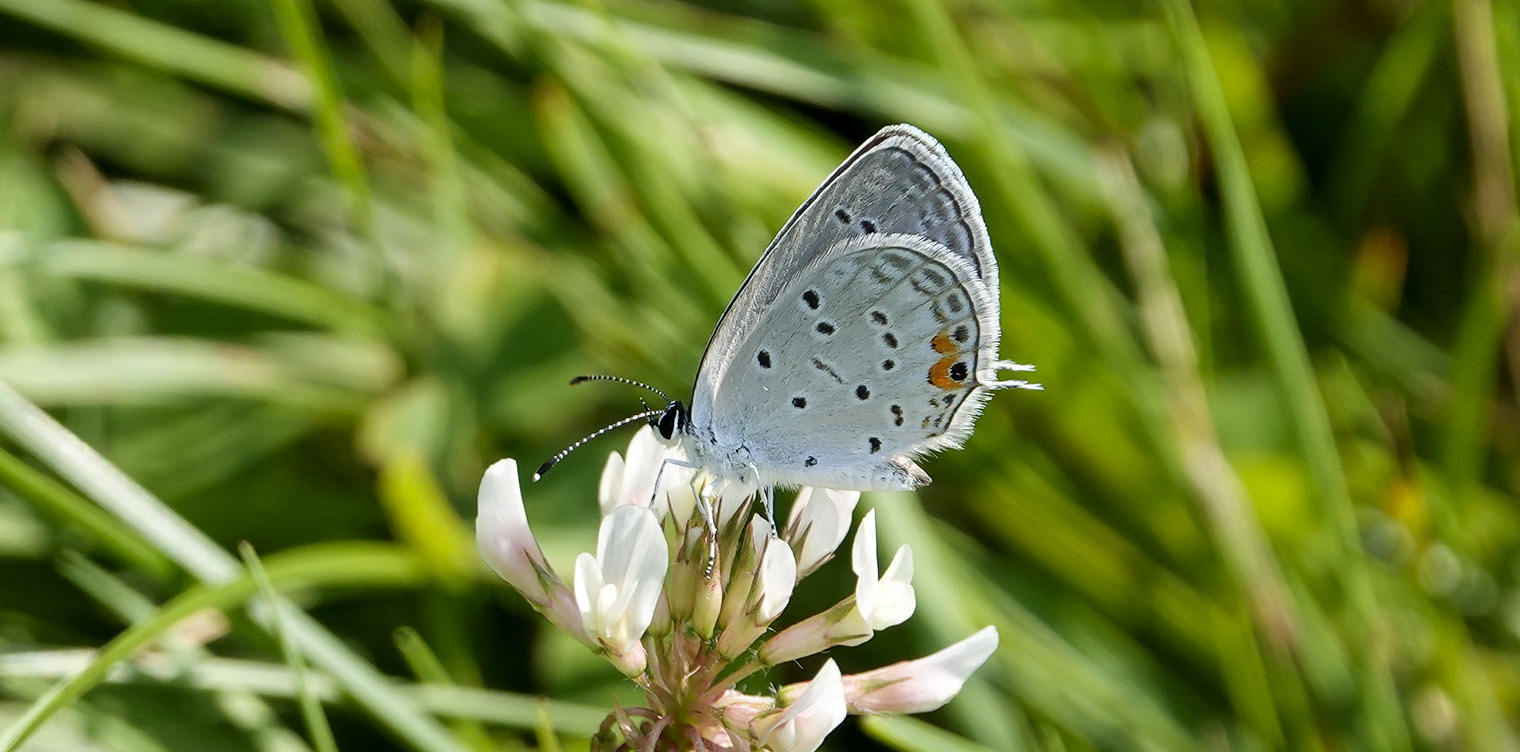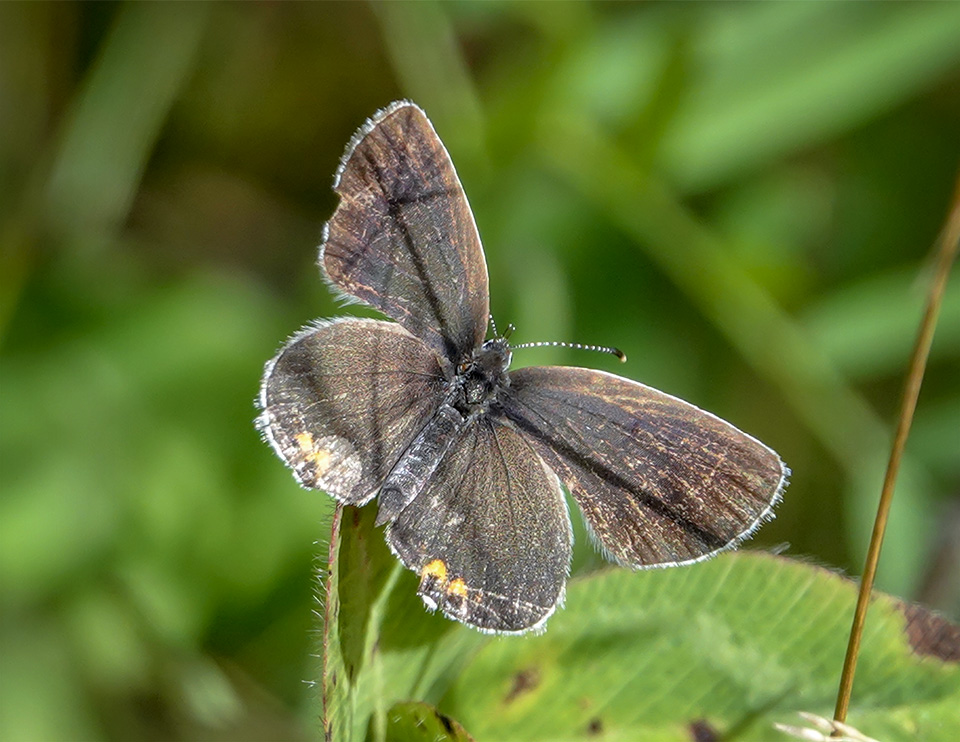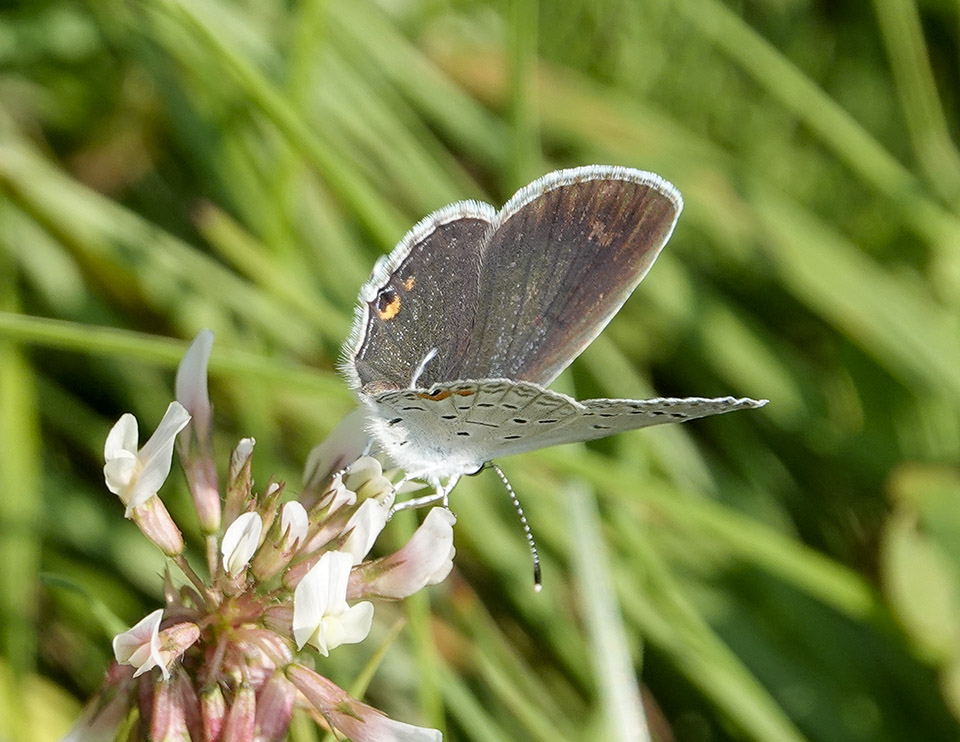Butterflies of the Adirondacks:
Eastern Tailed-Blue (Cupido comyntas)

The Eastern Tailed-Blue (Cupido comyntas) [1] – also identified as Everes comyntas in some sources [2] – is a small butterfly that may be seen in the Adirondack Mountains of upstate New York in summer. It derives its name from the narrow tail on the hind wing, which is just visible on these photos.
Eastern Tailed-Blue: Identification

The Eastern Tailed-Blue is a small butterfly, with a wingspan of ¾ to 1 inch. [3] The under side of the hind wing is pale gray with distinct black spots and several orange spots at the outer margin near the tail. [4] [5] [6] Like other blues, Eastern Tailed-Blues are sexually dimorphic. [7] From the top, males are iridescent blue, [8] while summer females are brown.
Color patterns vary by season. [9] In the spring, some females have blue at the base of the wings. [10] The wing span is 3/4 inch to 1 inch. [11] Early flights of this species tend to be smaller and more distinctly marked. Spring females may be deep blue from above; females from later generations are more often brownish from above. [12]
This butterfly can be easily mistaken for an Azure or a Silvery Blue. The Eastern Tailed-Blue can be distinguished from these species by the presence of the tail, as well as the small orange spot near the tail. [13] However, some specimens are worn, with the tails missing and the orange spots muted.
Eastern Tailed-Blue: Life History

Male Eastern Tailed-Blue butterflies patrol near the host plants during the day time. Females lay their pale green eggs on flower buds or young leaves. [14] [15] [16] The larva of the Eastern Tailed-Blue is hairy, dark green or various shades of brown to pale yellow, with dark dorsal stripe and a brown head. [17] [18]
Caterpillar hosts include plants in the legume family, including White Clover, Red Clover, and Cow Vetch. [19] [20] [21] The Eastern Tailed-Blue's chrysalis is pale green and tan, with black or whitish spots. [22]
Adult butterflies can be found on flowers close to the ground, including white sweet clover, winter cress, cinquefoils, and asters. [23] [24] [25] Eastern Tailed-Blues sometimes bask with their wings at a 45 degree angle. [26] [27]
Eastern Tailed-Blue: Habitat and Range
From the ecological standpoint, the Eastern Tailed-Blue is a generalist. [28] This butterfly is said to be one of the East's most abundant butterflies, having adapted readily to human activities. [29] [30] [31] Typical habitats of the Eastern Tailed-Blue are open, sunny places, [32] [33] including meadows, forest clearings, disturbed areas, and city lots. [34]
The range of Eastern Tailed-Blues includes southeastern Canada and the eastern part of the US, west to Western North Dakota. [35]
Eastern Tailed-Blue: Flight
Although the Eastern Tailed-Blue is said to be a widespread and abundant species which flies throughout warm weather, [36] its flight period, as with all butterflies, varies with region and shifts from year to year. In parts of its range, its first flight begins in early spring. [37]
- In Florida and other parts of the deep South, it flies from February through November. In the northern parts of its range, it has three broods, from April to November. [38]
- In Massachusetts, there are reportedly three flights. The first is from mid-May through early June. The second is from mid-July through late July. The third is from mid- to late August through mid- to late September. [39]
- In the New York City region of New York State, it flies from mid-April through mid-September. [40]
The flight period and abundance of the Eastern Tailed-Blue within the Adirondack Park can only be roughly estimated, based mainly on the limited number of verified sightings on Butterflies and Moths of North America (BAMONA) and reported observations on iNaturalist.
- The advantage of iNaturalist is that it is a popular citizen science web site that attracts many observers, in part because it covers both plants and animals and in part because the process of submitting an observation is very easy. The disadvantage is that an individual observation can achieve "research-grade" status by being confirmed by the observer and one additional individual, who may or may not have expertise in that particular taxa.
- The advantage of BAMONA is that sightings are verified by regional specialists who are recognized experts. The disadvantage is that there are fewer sighting records for most species, partly because the site covers only butterflies and moths and partly because the process of submitting a sighting is more complicated.
- Both data sets share a common problem of citizen science: reported trends may reflect trends in the number of observers and their willingness to submit reports, not the abundance of the butterfly in question. In addition, the Eastern Tailed-Blue is a very small, fast-moving butterfly, adept at hiding in low vegetation and difficult to identify without a clear view. As a result, the number of recorded sightings probably does not reflect this species' abundance.
With these caveats in mind, it appears that the flight period for the Eastern Tailed-Blue in the Adirondacks extends from late spring through early September. [41]
- Eastern Tailed-Blues have not been frequent guests at the Paul Smith's College VIC Native Species Butterfly House. In 2012, these butterflies were present 3 August and then from late August to early September. None were recorded in the Species Logbooks for 2013 or 2015. In 2016, Eastern Tailed-Blues were recorded on 11 and 22 July.[42]
- BAMONA lists only a few verified sightings for Eastern Tailed-Blues in the Adirondack Park, with sightings in very late June, late July, and early September. [43]
- Observations from iNaturalist suggest that the number and flight period for the Eastern Tailed-Blue, like other butterflies, varies from year to year. In 2016, there were two Adirondack Park iNaturalist observations, both from early September. [44] In 2017, there were three observations, all in late May. [45] In 2018, there was only one iNaturalist observation for the Adirondack region, in mid-September. [46] In 2019, four Adirondack Park observations were recorded, from late July through early September. [47] In 2020, there were 36 Adirondack Park observations, from early July through early September. [48] In 2021, there were 17 Adirondack Park observations, from mid-June through mid-September. [49] In 2022, there were 6 Adirondack Park observations, from mid-July through early September. [50]
References
- Susan Grimm Hanley. Interpretive Naturalist, Paul Smith's College Native Species Butterfly House. Species Logbooks.
- Butterflies and Moths of North American. Species Profiles. Eastern Tailed-Blue. Sighting records: 9/9/12; 9/9/12; 6/26/2015; 9/14/2018; 7/26/2019. Retrieved 2 September 2019.
- iNaturalist. Eastern Tailed-Blue. Cupido comyntas. Retrieved 27 June 2021.
- iNaturalist. Adirondack Park Sightings 2016. Eastern Tailed-Blue. Retrieved 2 September 2019.
- iNaturalist. Adirondack Park Sightings 2017. Eastern Tailed-Blue. Retrieved 2 September 2019.
- iNaturalist. Adirondack Park Sightings 2018. Eastern Tailed-Blue. Retrieved 2 September 2019.
- iNaturalist. Adirondack Park Sightings 2019. Eastern Tailed-Blue. Retrieved 27 June 2021.
- iNaturalist. Adirondack Park Sightings 2020. Eastern Tailed-Blue. Retrieved 27 June 2021.
- iNaturalist. Adirondack Park Sightings 2021. Eastern Tailed-Blue. Retrieved 21 November 2022.
- iNaturalist. Adirondack Park Sightings 2022. Eastern Tailed-Blue. Retrieved 21 November 2022.
- Government of Canada. Canadian Biodiversity Information Facility. Species Bank. Eastern Tailed Blue. Everes comyntas. Retrieved 2 September 2019.
- Massachusetts Butterfly Club. Massachusetts Butterfly Species List. Eastern Tailed-Blue. Everes comyntas. Retrieved 2 September 2019.
- Massachusetts Audubon. Butterfly Atlas Species Accounts. Eastern Tailed-Blue. Everes comyntas. Retrieved 2 September 2019.
- McFarland, Kent P. and Bryan Pfeiffer. Vermont Butterfly Survey. Vermont Center for Ecostudies – Vermont Atlas of Life. Eastern Tailed Blue. Cupido comyntas. Retrieved 2 September 2019.
- Integrated Taxonomic Information System On-line Database. Cupido comyntas. Retrieved 2 September 2019.
- Integrated Taxonomic Information System On-line Database. Everes comyntas. Retrieved 2 September 2019.
- Iowa State University. Department of Entomology. BugGuide. Cupido comyntas. Sighting records: 8/10/08; 8/10/08; 8/17/11; 8/17/11. Retrieved 2 September 2019.
- National Audubon Society. Field Guide to Butterflies (New York: Alfred A. Knopf, 1981), pp. 491-492.
- Jeffrey Glassberg. Butterflies of North America (Sterling Publishing Company, 2011), pp. 108-109.
- Jeffrey Glassberg. Butterflies through Binoculars. The East. A Field Guide to the Butterflies of Eastern North America (Oxford University Press, 1999), p. 92, Plate 24.
- Jeffrey Glassberg. A Swift Guide to Butterflies of North America. Second Edition. (Princeton University Press, 2017), p. 127.
- Jim P. Brock and Kenn Kaufman. Kaufman Field Guide to Butterflies of North America (Houghton Mifflin, 2003), pp.124-125.
- Paul A. Opler. A Field Guide to Eastern Butterflies (The Peterson Field Guide Series, Houghton Mifflin Company, 1992,1998), pp. 74-75, 214-215.
- James A. Scott. The Butterflies of North America. A Natural History and Field Guide (Stanford University Press, 1986), pp. 395-396.
- Donald and Lillian Stokes. Stokes Butterfly Book. The Complete Guide to Butterfly Gardening, Identification, and Behavior (Little, Brown and Company, 1991), pp. 62-63.
- Paul A. Opler and George O. Krizek. Butterflies East of the Great Plains: An Illustrated Natural History (The Johns Hopkins University Press, 1984), pp. 109, 114-115, Plate 18.
- Rick Cech and Guy Tudor. Butterflies of the East Coast. An Observer's Guide (Princeton University Press, 2005), p. 138.
- David Carter. Butterflies and Moths (Dorling Kindersley, Inc., 1992), p. 93.
- National Academies of Sciences, Engineering, and Medicine. Learning Through Citizen Science: Enhancing Opportunities by Design. (The National Academies Press, 2018). Retrieved 2 September 2019.
